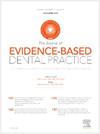IMPACT OF PULPECTOMY VERSUS EXTRACTION OF PRIMARY TEETH ON PATIENT-CENTERED OUTCOMES: A SYSTEMATIC REVIEW OF CLINICAL STUDIES
IF 4
4区 医学
Q1 DENTISTRY, ORAL SURGERY & MEDICINE
引用次数: 0
Abstract
Objectives
Although pulpectomy is recommended as the choice treatment for primary teeth with pulpal involvement, some clinicians and parents consider tooth extraction a viable option. This systematic review aimed to assess the impact of pulpectomy versus extraction of primary teeth on patient-centered outcomes.
Methods
Seven electronic databases and grey literature were searched on April 05, 2024. Two independent reviewers selected clinical trials comparing the impact of pulpectomy versus extraction of primary teeth on patient-centered outcomes. Studies not directly comparing pulpectomy versus tooth extraction were excluded. Critical data were summarized following the Synthesis Without Meta-analysis guideline. The risk of bias was assessed using the Version 2 Cochrane risk-of-bias tool for randomized clinical trials and the Risk Of Bias In Nonrandomized Studies of Interventions tool for nonrandomized clinical trials. The certainty of evidence was assessed using the GRADE approach.
Results
A total of 1228 studies were retrieved in the search. After the screening process, two studies were included. The outcomes evaluated were oral health-related quality of life (OHRQoL), dental anxiety, postoperative pain, and behavior. Qualitative synthesis indicated that children treated with pulpectomy exhibited improved OHRQoL and lower dental anxiety than those treated with tooth extraction. The treatment modality did not influence behavior and postoperative pain. Included studies present potential bias in specific domains. The certainty of evidence was low.
Conclusion
Pulpectomy demonstrated superior patient-centered outcomes, suggesting that it is a more favorable choice for treating primary teeth than tooth extraction.
牙髓切除与乳牙拔除对患者预后的影响:临床研究的系统回顾
目的:虽然牙髓切除术被推荐为治疗牙髓受累的首选方法,但一些临床医生和家长认为拔牙是一种可行的选择。本系统综述旨在评估除牙与拔除乳牙对患者预后的影响。方法于2024年4月5日检索7个电子数据库及灰色文献。两个独立的审稿人选择了临床试验,比较髓质切除与乳牙拔除对患者中心结果的影响。没有直接比较除牙与拔牙的研究被排除在外。根据综合无荟萃分析指南对关键数据进行汇总。使用Cochrane Version 2随机临床试验的偏倚风险工具和非随机临床试验的干预措施的非随机研究的偏倚风险工具评估偏倚风险。使用GRADE方法评估证据的确定性。结果共检索到1228篇文献。筛选过程后,纳入两项研究。评估的结果是口腔健康相关生活质量(OHRQoL)、牙科焦虑、术后疼痛和行为。定性综合表明,与拔牙组相比,髓质切除组患儿的OHRQoL得到改善,牙焦虑水平降低。治疗方式对行为和术后疼痛无影响。纳入的研究在特定领域存在潜在的偏倚。证据的确定性很低。结论牙髓切除术具有较好的以患者为中心的治疗效果,是治疗乳牙较好选择。
本文章由计算机程序翻译,如有差异,请以英文原文为准。
求助全文
约1分钟内获得全文
求助全文
来源期刊

Journal of Evidence-Based Dental Practice
DENTISTRY, ORAL SURGERY & MEDICINE-
CiteScore
6.00
自引率
16.70%
发文量
105
审稿时长
28 days
期刊介绍:
The Journal of Evidence-Based Dental Practice presents timely original articles, as well as reviews of articles on the results and outcomes of clinical procedures and treatment. The Journal advocates the use or rejection of a procedure based on solid, clinical evidence found in literature. The Journal''s dynamic operating principles are explicitness in process and objectives, publication of the highest-quality reviews and original articles, and an emphasis on objectivity.
 求助内容:
求助内容: 应助结果提醒方式:
应助结果提醒方式:


